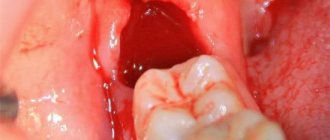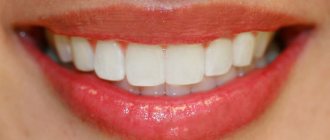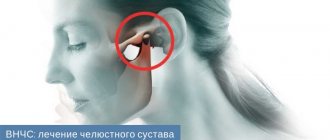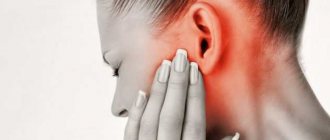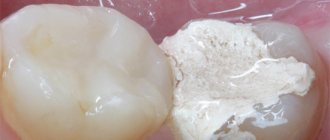Why is this happening?
The most common causes are the following factors:
- Presence of carious cavities. In this case, pain occurs when eating. Discomfort extends to the entire dentition.
- A cyst localized on the root of a tooth. When it reaches its maximum size, the neoplasm can compress the nerve endings, which is what causes this alarming sign.
- Inflammation of the pulp. In the presence of this dental disease, acute, unbearable radiating pain occurs. The problem is only in one tooth, but it feels like the entire dentition is bothering you.
- Enamel hyperesthesia. We are talking about increased sensitivity of units. When eating foods that are too hot, cold, sour or sweet, a person feels severe pain.
- Trinitarian neuralgia. The most common cause of this symptom. The pain is very piercing; there is a feeling that absolutely the entire lower part of the face, including all the teeth, is bothering.
There are also a number of pathological processes that are not dental. For example, we can talk about ear pain. Discomfort spreads to the jaw, the pain is throbbing and acute. Having eliminated the root cause (that is, inflammation in the ear), pain in the oral cavity will go away on its own; no separate treatment is required.
Why does pain occur in the gums and jaw?
One of the most common causes of pain at the end of the jaw is the eruption of wisdom teeth. This problem is most often encountered by patients aged 17-25 years. When the third molars grow abnormally, the symptoms are most pronounced. The clinical picture is also characterized by redness and enlargement of the gums, swelling of the cheeks, and inflammation of the cervical lymph nodes.
Possible causes of pain in the gums also include the following diseases.
- Gingivitis. Inflammation of the mucous membrane of the gums, accompanied by redness and bleeding. Occurs due to poor oral hygiene. Tends to be chronic. Increases the risk of developing more serious gum problems.
- Periodontitis. Periodontal inflammation with subsequent destruction of the periodontal junction. Develops with untreated gingivitis. Characterized by the formation of periodontal pockets and ulcers. Leads to loosening and loss of teeth.
- Stomatitis. Inflammation of the oral mucosa. Appears as blisters on the gums. Develops as a result of a burn of the mucous membrane, herpetic or candida infection.
- Tooth cyst. Formation of a dense capsule near the root of the tooth. Experts include jaw injuries and mechanical damage to the gums, acute respiratory diseases, advanced caries or pulpitis as the causes of this problem.
Pain in the gums can occur after complex treatment or tooth extraction. Normally, the discomfort goes away after 3-7 days. If discomfort persists for more than a week, you should consult your doctor.
Ways to eliminate pain
You need to visit a dentist as soon as possible to identify the specific cause of the discomfort. Self-medication will not be successful; such actions can only lead to the development of complications. At home, you can only reduce pain for a short time in order to wait for a trip to a specialist:
- Painkillers. They will help reduce the manifestation of pain, regardless of what caused the symptom. You can take Nise or Ketarol according to the instructions. If there is nothing suitable, a Paracetamol tablet will do.
- Infusion of chamomile. Pour boiling water over a tablespoon of dry raw materials. When the liquid has cooled, rinse your mouth.
- Soda + salt. Dissolve a teaspoon of salt + baking soda in a glass of warm water. You need to rinse your teeth every two hours.
Aching teeth: causes of pathology
When a patient comes to see a dentist and asks why his teeth are hurting for no reason, every good doctor will answer that this does not happen. There are always reasons. Any dental problem has its roots, and aching pain in the teeth is no exception. Another point is that the causes of this symptom are quite extensive and can be associated with a number of characteristics of the body and disturbances in the functioning of its systems. Experts identify more than a dozen factors that can cause aching pain in the teeth.
- Congenital hyperesthesia.
Increased sensitivity of enamel can be inherited, which is why a person may experience discomfort when exposed to temperature and chemicals. - Chips, cracks and other damage to the enamel.
Tooth injuries lead to dentin exposure and also facilitate the penetration of pathogenic microorganisms. - Thinning and weakening of enamel.
This can happen for several reasons. First of all, due to a lack of vitamins and minerals. The second common reason is weakening of the enamel as a result of frequent whitening procedures. - Caries and its complications.
Typically, aching pain in the teeth occurs in the middle stages of the disease. - Periodontal diseases in the active stage.
With periodontitis and periodontal disease, the necks of the teeth are exposed, which makes them (and surrounding tissues) very sensitive to irritants. The same applies to the wedge-shaped defect. - Infectious diseases,
especially chronic ones. Influenza, sinusitis, sinusitis - these diseases can sometimes provoke aching pain in the teeth and jaw. - Problems with the gastrointestinal tract.
- Stress, fatigue, lack of sleep.
- Hormonal disbalance.
Often, aching pain in the teeth occurs during pregnancy. - Inflammation of the trigeminal nerve,
when the pain “radiates” to the teeth. - Allergic reaction
to medications.
Preventive actions
To reduce the risk of dental diseases, you should follow these rules:
- Brush your teeth twice a day.
- Visit the dentist twice a year.
- Preventative professional cleaning of units once a year.
- Avoiding foods that are too hot or cold.
- Carry out enamel whitening only in trusted dental centers.
- Treat your teeth in a timely manner.
- Be more attentive to your health and avoid complications such as otitis media.
- Get rid of bad habits.
- Choose a paste without abrasive particles.
- Additionally, use an antibacterial mouthwash, dental floss and irrigator.
Diagnosis of pathology
For any manifestations of pain and discomfort, you should contact a specialist as soon as possible. Only a qualified doctor can correctly diagnose and identify the exact cause of the problem. If a patient comes with a complaint of aching pain in the teeth, a number of standard diagnostic procedures are first performed:
- visual examination of the oral cavity using a probe;
- tracking reactions to temperature stimuli;
- X-ray examination, which can reveal the presence of hidden problems and complications (granulomas, cysts, etc.).
If the pain and aches in the teeth are not directly related to dentistry, the attending physician refers the patient to other specialists. Most often this is a neurologist and maxillofacial surgeon. The localization of pain also helps to determine the root cause.
- Local.
Aching pain covers one or more teeth. This is usually associated with injuries and dental diseases. In some cases, this is a consequence of infectious diseases. - Generalized.
The entire dentition “aches.” The reasons why all teeth ache are usually associated with pathologies and diseases of the enamel.
The teeth of the lower jaw often ache more (especially the front incisors). In many people, they react more strongly to temperature changes, chemical irritants and inflammation of the trigeminal nerve, when pain responds in the anterior part of the lower jaw. On the other hand, the answer to the question why the lower teeth ache is exactly the same as in the case of the upper teeth: there are no separate reasons.
How is arthritis of the lower jaw joint treated?
If pain and stiffness symptoms occur, it is necessary to ensure the TMJ rests. Move your jaw less, take only liquid food, and do not clench your teeth tightly. Visiting the dentist is a must. Only a qualified specialist will be able to tell why the joint is inflamed and prescribe the optimal treatment. Diagnosis consists of blood tests and x-rays. Depending on the situation, we recommend:
- cold compresses;
- drug treatment (broad-spectrum antibiotics, painkillers);
- physiotherapy.
If conservative treatment is ineffective, surgery will be prescribed. Traditional methods of treatment are not only ineffective for arthritis of the temporomandibular joint, they are often dangerous. Decoctions, compresses and ointments according to grandmother's recipes can relieve pain and swelling, but they will not remove the cause of the disease; moreover, some of them can inflame the joint even more. The consequences are impossible to predict, especially with the hematogenous method of infection of the joint. 20% of patients who treated themselves develop joint paralysis.
Causes of osteomyelitis
Penetration of bacteria into bone, which traditionally occurs as follows:
- against the background of tooth damage by caries, that is, by odontogenic means. First, microorganisms penetrate the pulp, after which they enter the hard tissue through the lymph nodes or canals;
- after fur. tooth damage: dislocations, fractures, operations, etc.
- due to the penetration of infection during ENT diseases, skin inflammation, when microorganisms from one source of inflammation pass into the bone.
Prevention of aching teeth
The best way to prevent an unpleasant symptom is to follow preventive measures. Despite the fact that the enamel itself is very strong, improper lifestyle and exposure to the external environment gradually weaken and destroy it. If you have sensitive enamel, you need to carefully choose hygiene products. In particular, it is recommended to avoid hard toothbrushes and use toothpastes with calcium and fluoride. An equally important point is the right diet. It is necessary to reduce the consumption of spicy, sour and sweet foods to a minimum, and give preference to fermented milk products and foods high in vitamins A and B. Temperature changes are a big stress for sensitive enamel, so the best solution is to drink drinks at room temperature.
Publisher: Expert magazine about dentistry Startsmile.ru
Author of the material: Yaroslav Ikonnikov
Structure and functions of the temporomandibular joint
The joint is formed by the head of the horn of the lower jaw and the articular surface (fossa) of the temporal bone. Between these bone formations there is a fibrous intra-articular disc, which is fused on all sides with the joint capsule. Ligaments and muscles help keep the joint in the correct position. They limit the range of motion in the joint. Attempting to exceed this functional limitation causes pain and prevents damage to the TMJ.
The main function of the joint is to ensure movement of the lower jaw in three directions:
- vertical: opening and closing the mouth;
- horizontal: lateral displacements of the lower jaw relative to the upper;
- sagittal: movement of the lower jaw back and forth relative to the upper.
The combination of movements of one jaw relative to the other allows us to chew, speak, and express emotions through facial expressions.

